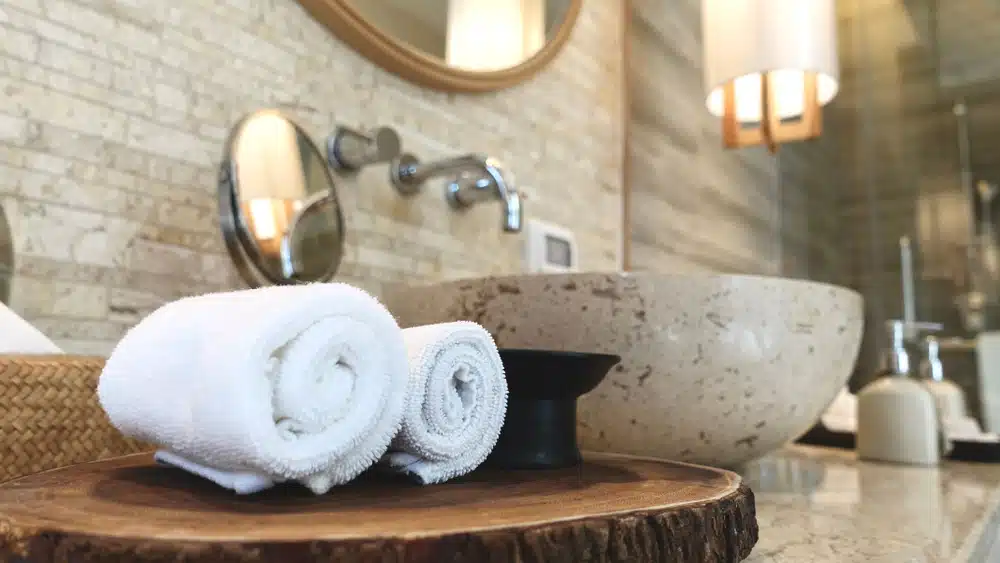
Many people experienced increased stress and anxiety last year due to the unprecedented times. Over the course of the pandemic, more than two thirds of adults say they have experienced increased stress. Physical and mental wellness are now more important than ever to them.
Due to this, after vaccinations, people are visiting spas more frequently in search of some much-needed TLC, giving spa businesses a significant boost. In other words, if you’re looking to enter the wellness industry, 2024 might be the right year! You can count on us to help you get it right.
Having skilled practitioners isn’t the only key to a successful spa business. Running a spa and growing it requires a solid plan and effective management. Initially, it may seem overwhelming, but we will help you through it.
Creating a successful spa business is simple with our comprehensive guide. The following guide will help you strategise your way into the spa industry, whether you want to open a day spa, a mobile spa, a massage spa, or a spa at home. Let’s jump right in.
Opening a spa checklist
Opening a spa can be a challenging yet rewarding endeavor. To ensure a successful launch, it’s important to have a comprehensive checklist that covers all aspects of the business. The first step is to research and select a location that is easily accessible and has ample parking. Next, you need to obtain the necessary licenses and permits, including zoning permits, health department permits, and business licenses.
You should also invest in quality equipment, such as massage tables, chairs, and spa products. Hiring a team of experienced and licensed therapists is crucial, and it’s important to develop policies and procedures that ensure a consistent level of service. Developing a marketing plan to reach your target audience and creating a user-friendly website is also key.
By following a thorough checklist, you can open a successful and profitable spa that provides clients with a relaxing and rejuvenating experience.
-
Understand the market
You need to understand the market scenario before choosing a name and hiring practitioners. To determine what works and what doesn’t, you must know your target audience, your competitors, and the current trends. You will gain a better understanding of what it is like to own a spa business. To get started, follow these steps:
Conduct your research
Researching the market skilfully is the first step towards opening your own spa. Engagement on social media platforms such as Facebook and Instagram will help you gain an understanding of what’s trending, what people are looking for, and what each spa offers.
Even better, you can arrange an appointment with your local rivals to observe how they run their business and get an insight into their setup. Simple as that.
Know the target customers
Most people agree that spas are primarily geared towards attracting women, so spas operate in a way to cater to them.
Despite the fact that nearly half of spa visits nowadays are made by men, they remain an untapped market due to their continued neglect. It is, however, a growing trend for many spas to take advantage of this opportunity.
You must understand your target clients before you start your spa business so that you can work out a plan based on their tastes and preferences.
Men, pregnant women, toddlers, teens, and pregnant women are some common demographic targets. You may wish to target bachelorette parties or birthday parties if you plan to provide a mobile spa service.
Once you’ve completed it, you’ll have a better idea of what your company needs. Initially, target a small number of clients and then expand as you grow.
Identify your niche
Businesses can differentiate themselves from the competition by focusing on a niche within a broader market. There are usually unmet needs or underserved niches in every industry.
Your business marketing should start with identifying your target audience, identifying an underserved market and researching your customer base.
You can offer grooming and waxing services to male clients if you plan to serve only them.
The services you offer can also be seasonal, for example, in the summer, you might want to offer something refreshing that focuses more on sun protection or tanning removal.
Finding out if your niche is already being served in your area is crucial. What are the chances that the region where you plan to operate will be able to generate revenue and profit? It is your niche that will guide your plans, frame your decor, and give you a clear vision for your home.
You need to become an expert in the spa market, at least at the local level. You should answer all the above questions before making any decisions about your business. Successfully running your spa business requires a thorough understanding of the market.
-
Setting your goals
Achieving something begins with setting goals. The goal gives you a reason to act, a reason to get up every day. You’ll know what you want to do once you understand the market.
Start by putting together a list of realistic short-term and long-term goals and prioritising them since they are of equal importance. Here are some examples of common goals:
- Achieving X massage hours per week.
- Expand to a team of 5 by the end of the year.
- Add four new massages to the menu by the end of the year.
- Achieve a profit margin of 30% by the end of 5 years.
You will perform better and make your spa the best in the area by setting deadlines for these goals. To simplify the process, you can also use a free template.
-
Finding the ideal location
What’s the secret to a successful spa? Location. Yes, you read that correctly. Before you settle on a spa rental location, it is crucial that you do a great deal of research before deciding.
Choose a location that will appeal to your target audience. The location of your spa will be advantageous if you plan to offer outdoor services.
When searching for a location, here are some top tips:
- Parking availability
- Surrounding businesses
- Competitors nearby
- Visibility of your spa
- Type of area
- Accessibility
- Foot traffic
- Demographics
The zoning of an area is an important legal aspect to consider before choosing a location. Some places allow businesses to be in residential areas, while others do not. Make sure you research the rules at your destination before you get there.
Now that you have decided on a location, one more thing must be considered, what is the size of the area needed? Ask yourself these questions to gain a better understanding:
- How many people are on staff, and how many people will I serve simultaneously?
- Do I need more than one treatment room?
- What is the purpose of each treatment room individually?
- How big should the waiting area be?
- In terms of reception, storage, and staff areas, what are the general requirements of a spa?
- How are you planning to use the common areas like locker rooms?
Target audience and location must be perfectly matched. The way you deliver spa experiences to your clients will be elevated if you create a lively yet calming spa environment.
The right way to decorate a women’s room is with pink walls and bright flowers. A designer can help you develop your ideas by pointing out factors that you might have overlooked.
-
Calculating The Start Up Costs
In this article, we have discussed a number of aspects directly related to a spa business to help you envision the business you want. Let’s get down to business now.
When you are considering starting a spa business, you may ask yourself, “How much does it cost? ”. Opening a spa business requires a multitude of investments, just like any other business. Starting up a spa typically involves the following costs:
- Registration of the business
- Rent of the location
- Construction costs and furniture
- Utilities like water and electricity
- Equipment for the spa-like massage table and facial chairs
- Staff salaries
- Initial supplies and inventory like massage oils and candles
- Certifications and licenses
- Marketing costs
- Legal and consulting fees
- Website
Other costs that can’t be predicted at the beginning are just the tip of the iceberg. It can be challenging at this point but try to plan out most of your expenses.
In the early stages of any business, it’s important to predict the initial investment accurately, but there is a caveat: underestimating this number can lead to overestimating profits.
-
Financing Your Spa Business
In the case of a spa that has little or no capital, financing your spa is of utmost importance. As a business owner, you have many options for raising money for your organisation, and now that you know how much it costs, you can choose from any of the following:
- Your savings– Use your savings to cover some basic expenses.
- SBA Backed loans– The US Small Business Administration is the perfect place to get started with your financing. You can also increase the chances of getting a loan by creating a proper spa business plan.
- Equipment financing – a business owner who needs upfront cash for a specific task such as hiring or purchasing equipment usually goes for equipment financing. One-time expenses can be covered by this.
- Help from friends and family – Asking for help from your family and close friends can be helpful at the beginning.
-
Hiring Your Team
It is impossible to beat the feeling of receiving genuine appreciation from your customers. The goal of a spa visit is to make your clients feel comfortable and leave an indelible impression. Aestheticians and therapists are perfectly positioned to provide clients with a calm day, given their expertise in the field.
As your business grows, you may have to hire additional team members for specific tasks. You may start with a small team, handling most of the work yourself.
Choosing the right therapist, aesthetician, and technician is crucial if you want to provide the best service to your clients.
Your spa’s staff plays a significant role in how relaxed and comfortable your customers feel, not just themassage rooms.
You will ensure that your customers feel comfortable and relaxed by having the right support staff, from the receptionist to the person who is escorting them to their rooms.
For reaching out to people you need to hire, you’ll need a variety of resources such as ads, referrals, job fairs, internships, and more. As well as making sure they have the right license for the job they’re applying for, ensure that they have the required education.
Your final decision should be based on your interview with qualified candidates.
-
Creating your spa menu
Your spa menu will provide them with a better understanding of what you offer rather than simply telling them about it.
The following tips will help you design a spa menu that captures the attention of your guests:
- The importance of categorising treatments cannot be overstated.It is common for spas to offer a combination of these services – massages, skincare, and body treatments.
- Describe each service as a tour guide for your offerings.Make your offerings more appealing by using adjectives.
- Your menu will be more readable if you select the right font and size.
- Clients will find it helpful if you provide information such as your timings, contact information, address, booking link, etc.
- Combo packages can also be offered to attract clients. Combination packages such as immunity boosters and stress-relief packages are becoming increasingly popular.
In order to break even as soon as possible, you will need to price your offerings both according to your target audience and according to your expected expenses. Make sure all these factors are taken into account when developing your pricing strategy.
Your brand identity should also be reflected in the menu. As a business, you are defined by your brand. Decide on a name for your spa that reflects your individuality and a logo that effectively communicates your message. In addition to being appealing to the target audience, the name must also be easy to pronounce.
As an example, using terms such as “energised” or “vital” will help if your target audience is men.
The first step is to create a brand that will help you connect emotionally with your customers.
-
Getting your first customers
Your team has been hired, market research has been done, and now it’s time to get started!
It is important, however, to establish a customer base to launch your business. New customer appeals can be achieved in the following ways:
- Inquire about your new opening with your old clients if you’ve worked in a spa before.
- Establishing contacts in the local community is a great place to start if you’re new to the field.Exchange promotional materials with hair salons, gyms, etc. in your area to begin your co-marketing practice.
- You can improve your local visibility and online presence by listing yourself in online directories such as Google My Business, Yelp, etc. In this way, your customers will be able to see what you have to offer, read reviews, and book directly from your website.
- Initially, offer attractive packages and introductory discounts to attract large crowds.
Give special attention to these first customers. Your customers will return to your spa if they are delighted at every touchpoint, as well as recommend it to their families and friends.
-
Choosing the right spa scheduling software
You need to be multifaceted when you start a small spa business, as you are not only a massage therapist, but also a marketing manager, an accountant, and an HR manager.
It would be great if this administrative burden could be reduced? Spa management software plays a key role in this situation.
We are living in an era of automation. A report found that scheduling software increases customer satisfaction by 52% and boosts marketing and sales by 30% in businesses like spas.
It makes your job effortless and dramatically improves the customer experience if you choose the right spa scheduling software.
You’ll use them for a variety of tasks, including:
- Taking online appointments– A recent survey found that 94% of respondents might change service providers if an online booking option was available. Providing your clients with the option to make bookings online 24×7 will provide them with flexibility and remove friction from the process. In addition to saving time and money, you will also be able to use them to improve your spa.
- Online payments– Contactless payments have become the norm post-Covid. The right way to make a payment is through an online payment option that is secure. Your transactions will also be organised in one place.
- Client database– You can collect and store complete client information, including basic information and personal preferences, for each appointment you book with them. A personalised experience is crucial in this field, so you need to implement the right strategy.
- Managing staff– Manage your team’s availability and their services, as well as their productivity independently. Also, your staff will be able to log in and manage their schedule, thereby becoming more efficient and responsible.
Frequently asked questions
How do I start a spa?
Starting a spa typically involves conducting thorough market research to identify your target audience, developing a comprehensive business plan, and securing financing to cover your startup costs such as equipment, rent, and supplies. Additionally, you will need to navigate the legal and regulatory requirements for opening a business in your location, such as obtaining necessary licenses and permits.
How profitable is owning a spa?
The profitability of owning a spa can vary depending on various factors such as the location, size, and services offered. However, many spas can be profitable, particularly if they offer high-quality services, establish a loyal customer base, and effectively manage their expenses.
Conclusion
Starting a spa business can be a rewarding and exciting venture for those passionate about wellness and beauty. The first step in starting a spa business is to conduct thorough research on the industry, including market trends, competitors, and target demographics. Once you have a solid understanding of the market, it’s important to develop a business plan that includes your vision, mission, and goals, as well as financial projections and a marketing strategy.
Finding a suitable location for your spa is also critical, as it should be easily accessible to your target market and have ample space for treatment rooms and amenities. Investing in high-quality equipment and hiring skilled and licensed staff is also important to ensure a positive customer experience. Overall, starting a spa business requires hard work, dedication, and a passion for the industry, but it can be a highly rewarding endeavor for those willing to put in the effort.
Jarred Musson is a versatile writer with a diverse educational background and a passion for all things business. Holding a Master of Science (MSc) degree in Marketing and a Bachelor of Arts (BA Hons) in Multimedia Journalism from Manchester Metropolitan University, Jarred possesses a unique blend of expertise that allows him to dissect and communicate complex business topics with clarity and precision.


